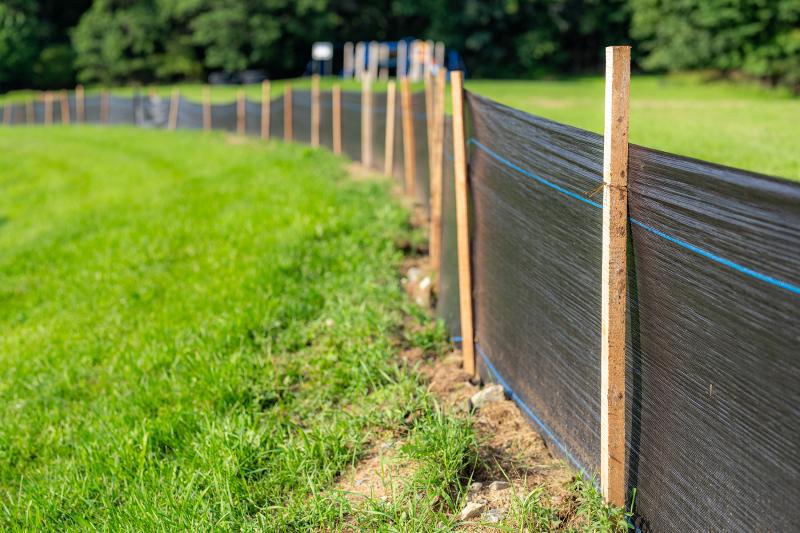Sussex County looks to strengthen stormwater regulations
Sussex County officials plan to draft additional rules to limit erosion from stormwater at large construction sites, which are susceptible to releasing sediment into nearby water bodies, potentially harming the environment.
After a presentation at the April 8 Sussex County Council meeting by the Sussex Conservation District staff about consequences of a mid-March storm that dumped 4 inches of rain, it was decided county and district staff would propose revisions to stormwater regulations and other action.
“Not to say there aren’t discharges where there might be problems with completed projects, but the primary focus that’s causing the problems that are getting a lot of attention are coming from active construction sites,” said District Coordinator David Baird.
County Administrator Todd Lawson presented images of sediment from construction that washed onto neighboring property and into waterways.
Lawson said options include increased education for developers and contractors, asking the state to step up enforcement of existing regulations, and requesting the state enact stricter laws – which could be a lengthy process – or having the county strengthen its own sediment and stormwater regulations.
Any changes to county rules would have to be crafted to avoid conflicting with state regulations, county officials said.
There has been increasing attention to the problems of controlling stormwater on construction sites in the past couple of years, particularly the past year, Baird said.
Jessica Watson, sediment and stormwater program manager for the conservation district, said her agency had spoken last year with council about the problems.
“As you recall, last year was a ridiculously wet year and we had a lot of construction issues with back-to-back storms, and every rain event was a 3-inch rain event,” she said.
Sediment and erosion controls are placed on the perimeter of construction sites in an attempt to keep sediment from washing into waterways. In a significant rainfall, such as one in March that dropped 4 inches in two hours, those controls are inadequate.
“They will become overwhelmed, and as you saw, there will be breaches,” Watson said.
Sediment and erosion controls are only adequate for a 1-inch rainfall, she said. Even a “super silt fence,” which uses a chain-link fence to support a silt fence, has its limits.
“Even though we did have a lot of fill on those areas, if you get a 4-inch rainfall event on bare dirt, the water’s going to move,” Watson said. “Unfortunately, these rainfall events really highlight any weak areas that we have on a project.”
Her office works to get compliance with county and state sediment and stormwater regulations. Last year, it worked with developers, builders and others to educate them about the problem and prompt action to reduce stormwater runoff.
There are particularly vulnerable stages of construction, when the ponds are not complete or trenches are open, and heavy rains pose the greatest risks, Watson said.
Water that migrates from construction sites contains suspended fine particles of sediment, some microscopic, which are difficult to remove and are carried to waterways, where they settle and can kill vegetation and otherwise harm the environment.
“That’s a long-term impact,” said Council Vice President John Rieley. “That’s expensive too. Our Inland Bays generate billions of dollars in revenue.”
Councilwoman Jane Gruenebaum said she’s concerned that the first step by construction crews is usually to clear trees from a site, leaving it exposed to stormwater erosion. She asked if there are better building practices.
Rieley suggested a prohibition on development in the spring, when there is greater chance of heavy rains.
While the county requires buffers of various widths, up to 100 feet to protect wetlands and water bodies, those may not be adequate for many heavy rains.
Hans Medlarz, a county engineer, said he could suggest a dozen steps, such as amending the stormwater ordinance to reduce the amount of land left bare during construction and changing requirements for sediment containment during work.
Existing rules can be helpful, but plans need to be designed based on the characteristics of each site, Medlarz said.
“The best practices fail in these instances because they are one-size-fits-all,” he said.
Councilman Steve McCarron said he wants to make sure any rules consider differences between characteristics of the east and west sides of the county, and do not harm farmers.
Baird said his office will incorporate changes sought by council into project reviews.
“Where I am on this is, if you want to build on your property, that’s fine, that’s great,” Rieley said. “Keep your dirt out of the water. I don’t want to see any dirt. I don’t want to see turbidity. I don’t want to see cloudy water.”












































